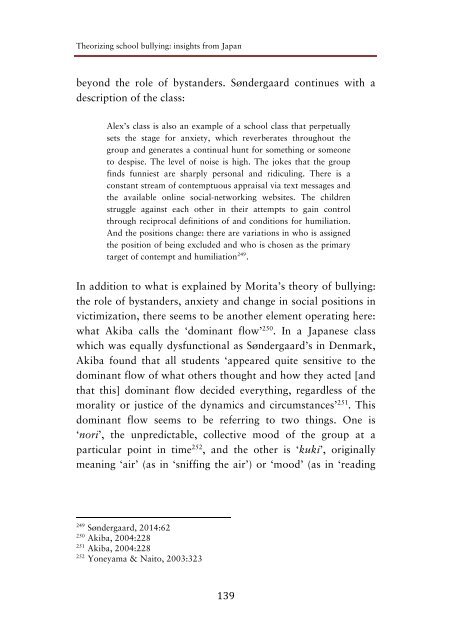Create successful ePaper yourself
Turn your PDF publications into a flip-book with our unique Google optimized e-Paper software.
Theorizing school bullying: insights from Japan<br />
beyond the role of bystanders. Søndergaard continues with a<br />
description of the class:<br />
Alex’s class is also an example of a school class that perpetually<br />
sets the stage for anxiety, which reverberates throughout the<br />
group and generates a continual hunt for something or someone<br />
to despise. The level of noise is high. The jokes that the group<br />
finds funniest are sharply personal and ridiculing. There is a<br />
constant stream of contemptuous appraisal via text messages and<br />
the available online social-networking websites. The children<br />
struggle against each other in their attempts to gain control<br />
through reciprocal definitions of and conditions for humiliation.<br />
And the positions change: there are variations in who is assigned<br />
the position of being excluded and who is chosen as the primary<br />
target of contempt and humiliation 249 .<br />
In addition to what is explained by Morita’s theory of bullying:<br />
the role of bystanders, anxiety and change in social positions in<br />
victimization, there seems to be another element operating here:<br />
what Akiba calls the ‘dominant flow’ 250 . In a Japanese class<br />
which was equally dysfunctional as Søndergaard’s in Denmark,<br />
Akiba found that all students ‘appeared quite sensitive to the<br />
dominant flow of what others thought and how they acted [and<br />
that this] dominant flow decided everything, regardless of the<br />
morality or justice of the dynamics and circumstances’ 251 . This<br />
dominant flow seems to be referring to two things. One is<br />
‘nori’, the unpredictable, collective mood of the group at a<br />
particular point in time 252 , and the other is ‘kuki’, originally<br />
meaning ‘air’ (as in ‘sniffing the air’) or ‘mood’ (as in ‘reading<br />
249<br />
Søndergaard, 2014:62<br />
250<br />
Akiba, 2004:228<br />
251<br />
Akiba, 2004:228<br />
252<br />
Yoneyama & Naito, 2003:323 <br />
139


